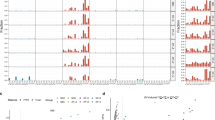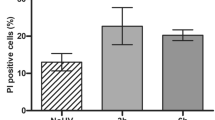Abstract
THE human hereditary skin disease xeroderma pigmentosum (XP) is characterised by extreme sensitivity to sunlight and a high incidence of sunlight-induced skin cancer. These symptoms seem to be correlated with a defect in the excision repair of ultraviolet-induced dimers1. Repair of DNA damage caused by chemical carcinogens belonging to the group of monofunctional alkylating agents was thought to be normal in XP cells, however, because after treatment with these agents the amounts of repair replication2,3 and the numbers of chromosome aberrations4 were similar in normal and XP cells. Contrary to this indirect evidence, it is reported here that direct measurement of the amounts of two products formed by alkylating carcinogens in the DNA and of the rate at which they are eliminated indicates that XP cells have a defect in this type of repair also.
This is a preview of subscription content, access via your institution
Access options
Subscribe to this journal
Receive 51 print issues and online access
$199.00 per year
only $3.90 per issue
Buy this article
- Purchase on Springer Link
- Instant access to full article PDF
Prices may be subject to local taxes which are calculated during checkout
Similar content being viewed by others
References
Cleaver, J. E. Nature 218, 652–656 (1968).
Cleaver, J. E. Mutat. Res. 12, 453–462 (1971).
Stich, H. F., San R. H. C. & Kawazoe, Y. Mutat. Res. 17, 127–137 (1973).
Sasaki, M. S. Mutat. Res. 20, 291–293 (1973).
Gerchman, L. L. & Ludlum, D. B. Biochim. biophys. Acta 308, 310–316 (1973).
Lawley, P. D. Mutat. Res. 23, 283–295 (1974).
Goth R. & Rajewsky M. F. Proc. natn. Acad. Sci. U.S.A. 71, 639–643 (1974)
Kleihues P. & Margison G. P. J. natn. Cancer Inst. 53, 1839–1841 (1974).
Nicoll, J. W., Swann, P. F. & Pegg, A. E. Nature 254, 261–262 (1975).
Goth, R. & Rajewsky, M. F. Z. Krebsforsch. 82, 37–64 (1974).
Kleihues, P. & Magee, P. N. J. Neurochem. 20, 595–606 (1973).
Lawley, P. D. & Brookes, P. Biochem. J. 89, 127–138 (1963).
Lawley, P. D. & Thatcher, C. J. Biochem. J. 116, 693–707 (1970).
Lindahl, T. Nature 259, 64–66 (1976).
Kirtikar, D. M. & Goldthwait, D. A. Proc. natn. Acad. Sci. U.S.A. 71, 2022–2026 (1974).
Kirktikar, D. M., Cathcart, G. R. & Goldthwait, D. A. Proc. natn. Acad. Sci. U.S.A. 73, 4324–4328 (1976).
Kuhnlein, U., Penhoet, E. E. & Linn, S. Proc. natn. Acad. Sci. U.S.A. 73, 1169–1173 (1976).
Druckrey, H., Schagen, B. & Ivankovic, S. Z. Krebsforsch. 74, 141–161 (1970).
Wolff, S., Rodin, B. & Cleaver, J. E. Nature 265, 347–349 (1977).
Cleaver, J. E. in Proc. 4th Life Sci. Symp. Mechanisms molec. cell. Tox., J. Toxicol. environ. Health (Suppl.) (in the press).
Bootsma, D., Mulder, M. P., Pot, F. & Cohen, J. A. Mutat. Res. 9, 507–516 (1970).
Smith, C. A. & Hanawalt, P. C. Biochim. biophys. Acta 447, 121–132 (1976).
Author information
Authors and Affiliations
Rights and permissions
About this article
Cite this article
GOTH-GOLDSTEIN, R. Repair of DNA damaged by alkylating carcinogens is defective in xeroderma pigmentosum-derived fibroblasts. Nature 267, 81–82 (1977). https://doi.org/10.1038/267081a0
Received:
Accepted:
Issue Date:
DOI: https://doi.org/10.1038/267081a0
This article is cited by
-
Defects in antioxidant defense and calcium transport in the epidermis of xeroderma pigmentosum patients
Archives of Dermatological Research (1991)
-
Removal of O6-methylguanine from DNA of normal and xeroderma pigmentosum-derived lymphoblastoid lines
Nature (1981)
Comments
By submitting a comment you agree to abide by our Terms and Community Guidelines. If you find something abusive or that does not comply with our terms or guidelines please flag it as inappropriate.



